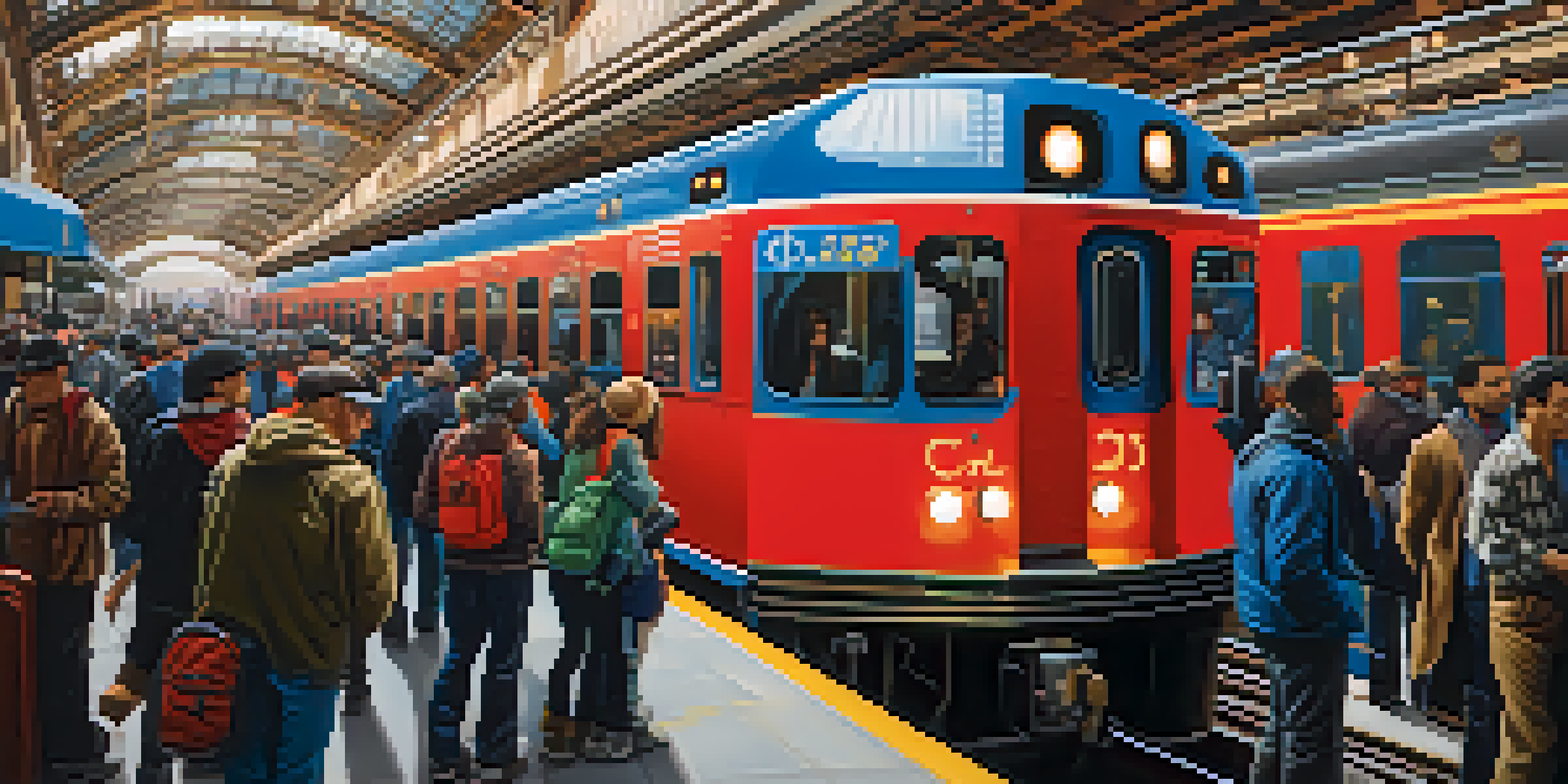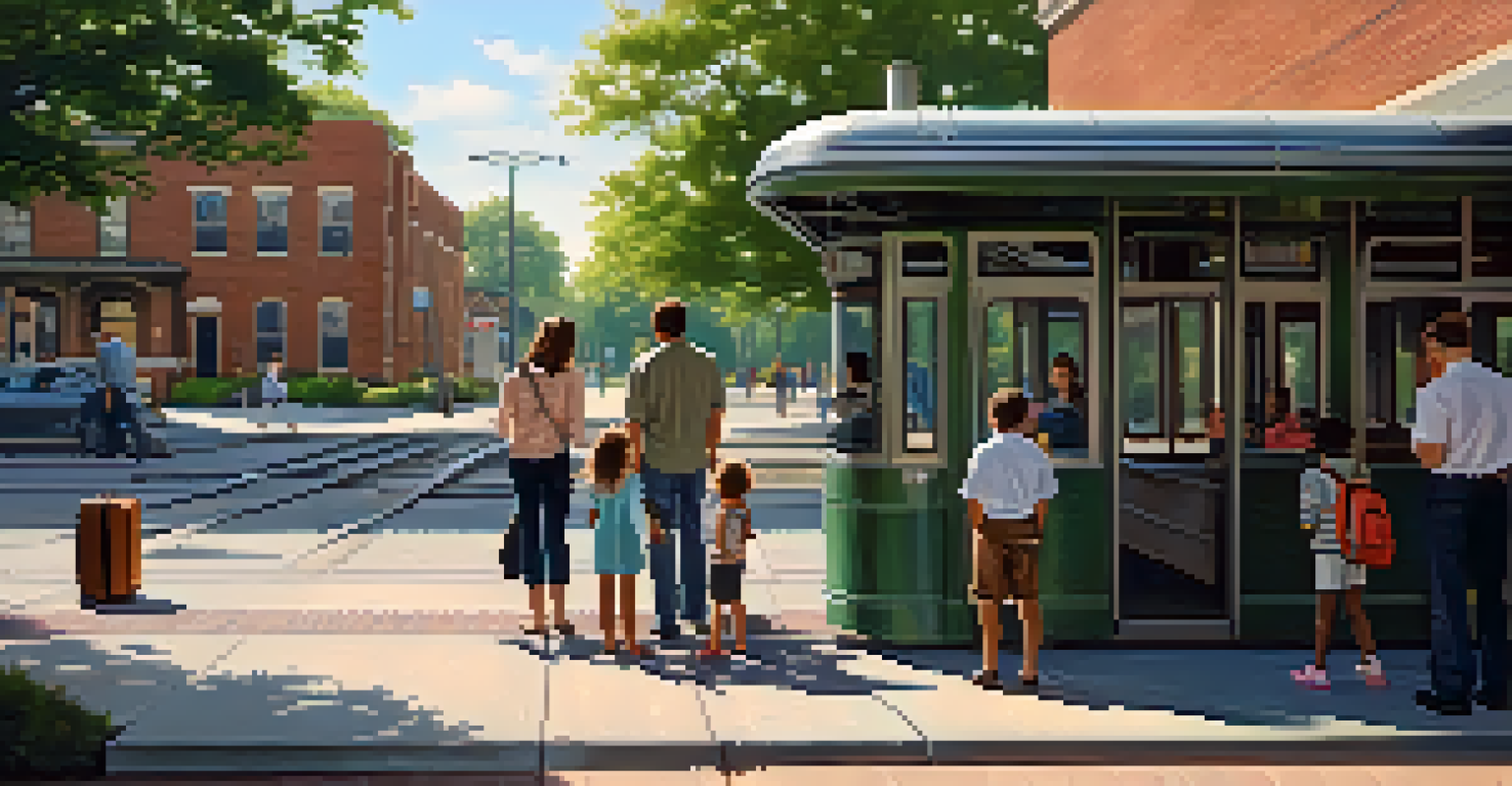The Impact of Chicago's 'L' Train on Urban Mobility and Growth

Introduction to the Chicago 'L' Train System
The Chicago 'L' train, short for 'elevated', is more than just a transit system; it's a vital artery of the city. Opened in 1892, it has transformed urban mobility, connecting neighborhoods and fostering economic activity. With its iconic red and blue lines, the 'L' serves millions of riders annually, making it a lifeline for residents and visitors alike.
Public transport is a vital part of a city’s infrastructure and an important tool for social equity.
From the bustling Loop to the serene suburbs, the 'L' provides an efficient means of transportation, reducing reliance on cars. This shift not only alleviates traffic congestion but also decreases carbon emissions, contributing to a more sustainable urban environment. The 'L' is a prime example of how public transit can enhance the quality of life in a bustling metropolis.
As we delve deeper into the impact of the 'L' train, we'll explore its influence on urban growth, social equity, and overall city dynamics. Each station serves as a gateway to various communities, highlighting the interconnectedness of Chicago's diverse neighborhoods and the role of public transport in shaping urban landscapes.
Boosting Accessibility and Connectivity
One of the most significant impacts of the 'L' train is its ability to enhance accessibility throughout Chicago. It links underrepresented neighborhoods to job centers, schools, and cultural institutions, fostering inclusivity. By offering a reliable and affordable means of transportation, the 'L' allows residents to pursue opportunities that may otherwise be out of reach.

For instance, a commuter living in the South Side can easily access downtown Chicago for work, contributing to a more diverse workforce. The connectivity provided by the 'L' makes it possible for people from various backgrounds to interact and collaborate, ultimately enriching the city's cultural fabric. This level of accessibility is crucial for fostering a thriving urban community.
Enhancing Accessibility for All
The 'L' train connects underrepresented neighborhoods to essential job centers and services, promoting inclusivity and opportunity.
Moreover, the 'L' train encourages a walkable city. With stations strategically placed near neighborhoods, residents are motivated to walk, bike, or use public transit instead of driving. This shift not only promotes healthier lifestyles but also strengthens community ties, as people engage more with their surroundings.
Supporting Economic Development
The 'L' train has been a catalyst for economic development in Chicago, transforming areas surrounding its stations. As businesses recognize the benefits of being near transit, we see an influx of cafes, shops, and service providers catering to commuters. This boom in local businesses boosts employment and creates a vibrant street life, making neighborhoods more attractive to residents and tourists.
The best public transport is one that connects people to their jobs and their communities.
For example, the revitalization of neighborhoods like Pilsen and Logan Square can be traced back to their proximity to the 'L'. As more people frequent these areas, property values rise, and investment pours in, creating a thriving economic ecosystem. This trend highlights the symbiotic relationship between public transit and local economies.
Additionally, the 'L' plays a crucial role in supporting tourism. Visitors can effortlessly navigate to attractions like Millennium Park and Navy Pier, enhancing their experience in the city. By promoting ease of access to popular destinations, the 'L' train helps sustain Chicago's reputation as a vibrant urban hub.
Environmental Impact and Sustainability
Public transportation systems like the 'L' train significantly reduce carbon footprints by decreasing reliance on single-occupancy vehicles. The convenience of the 'L' encourages more people to choose public transit over driving, contributing to lower traffic congestion and improved air quality. This aspect is particularly important in the face of climate change, as cities seek to implement sustainable practices.
Moreover, the 'L' train is designed to be energy-efficient. Its electric-powered system emits fewer greenhouse gases compared to traditional gas-powered vehicles. By investing in renewable energy sources to power the trains, Chicago can further enhance the sustainability of its transit system, setting an example for other cities to follow.
Catalyzing Economic Growth
The proximity of businesses to 'L' stations fuels economic development, attracting local shops and increasing property values.
As urban populations continue to grow, the role of public transit in combating environmental challenges becomes increasingly vital. The 'L' train not only facilitates mobility but also promotes eco-friendly practices, making it an essential component of Chicago's commitment to a greener future.
Social Equity and Inclusion
The 'L' train system plays a pivotal role in addressing social equity in Chicago. By providing affordable transportation options, it helps bridge the gap between different socioeconomic groups. This inclusivity is crucial for ensuring that all residents have access to essential services, employment, and recreational opportunities.
For instance, low-income communities that rely on public transit can access better job prospects and educational institutions, leading to upward mobility. The 'L' train's affordability compared to owning and maintaining a car makes a significant difference for many families. This access fosters a sense of belonging and community, which is essential for a thriving urban environment.
In addition, the 'L' train system has made strides in improving accessibility for people with disabilities. With the implementation of elevators and ramps at various stations, the 'L' is becoming more inclusive for all riders. This focus on social equity ensures that everyone can benefit from the city's public transportation resources.
Challenges and Future Developments
Despite its many benefits, the 'L' train system faces challenges that need to be addressed for continued success. Aging infrastructure, funding shortages, and maintenance issues threaten the reliability of the service. Addressing these challenges requires a concerted effort from city officials, transit authorities, and the community to secure the necessary resources for upgrades.
Future developments, such as expanding lines and improving station facilities, are essential to meet the growing demands of the city’s population. Incorporating technology, like real-time tracking and mobile ticketing, can enhance the commuter experience and attract new riders. By investing in innovation, the 'L' can remain a competitive option for urban mobility.
Promoting Environmental Sustainability
By reducing reliance on cars, the 'L' train helps lower carbon emissions and improve air quality, contributing to a greener Chicago.
Additionally, community engagement is critical in planning future developments. Involving residents in discussions about their transportation needs fosters a sense of ownership and helps ensure that the 'L' train continues to serve as a valuable resource for all Chicagoans.
Conclusion: The 'L' Train's Lasting Legacy
As we reflect on the impact of Chicago's 'L' train, it's clear that this transit system goes beyond mere transportation. It has shaped urban mobility, fostered growth, and enhanced connectivity across the city. The 'L' train is a testament to how public transit can improve lives and create vibrant, inclusive communities.
Going forward, it’s vital to continue investing in the 'L' to maintain its status as a backbone of urban mobility. By addressing its challenges and embracing future developments, we can ensure the 'L' remains a reliable and efficient mode of transport for generations to come. This commitment will ultimately contribute to a more sustainable and equitable Chicago.

In essence, the legacy of the 'L' train is not just about the tracks and cars; it’s about the connections it fosters and the opportunities it creates. As Chicago continues to evolve, the 'L' will undoubtedly remain a crucial part of its urban landscape, symbolizing resilience and progress.